![]()
![]()
![]()
Use LEFT and RIGHT arrow keys to navigate between flashcards;
Use UP and DOWN arrow keys to flip the card;
H to show hint;
A reads text to speech;
58 Cards in this Set
- Front
- Back
|
early christian art was found
|
in underground catacomb burials
|
|
|
old st peters in rome italy was built in the _____ century by ______ & _______, was commissioned by ____________, & uses ___________ & large ______ to support the _____
|
was built in the mid6th century by isidorus & anthemius was commissioned by justinian uses pendentives and large piers to support the dome
|
|
|
byzatine churches favored ______ over ______
|
mosaics over frescos
|
|
|
the ravenna image of emperor justinia combines ideas of religion & state regards __________ art
|
byzantine art
|
|
|
byzantine icon paintings commonly represented __________________________________
|
mary & Christ with saints & angels
|
|
|
etruscan sculpture was used to ____________, was found _____________, and was made of __________ and resembled ____________________
|
was used to decorate temple roofs was found in burials in tumuli was made of terracotta and resembles greek archaic sculpture
|
|
|
roman historical periods and the country of origin include
|
republic and empire in italy
|
|
|
portraits of patricians of the roman republic were ___________ & ___________________
|
realistic & serious
|
|
|
the first emperor augustus was _______ after his death
|
deified worshiped after his death
|
|
|
pont du gard in nimes france is _______
|
a bridge and was an aquaduct
|
|
|
the pantheon was _____________________________________________
|
a public temple of worship for all gods especially the sky gods
|
|
|
forums are public _____________________, in ____ were commisiiioned by or dedicated to _____________ and include _________________________________
|
are public gather ing places and cultural and social hubs of a roman city in rome were commissioned by or dedicated to emperors include colonnnaded plazas a basilica & temples
|
|
|
the colosseum or flavians amphitheater was ____________________________, made use of ________________________________, was made from ____________
|
was a public stadium built to entertain the masses accommodating 50,000 spectators made use of the arch & barrel vault for easy entry/exit was concrete with a marble veneer and decorative engaged columns
|
|
|
the arch of titys and trajans column used ____________________________
|
used an element of architecture as a freestanding sculptural monument in Rome
|
|
|
roman mosaics in pompeii were made from & placed
|
made from stone clay & glass pieces set into the floor
|
|
|
intuitive & atmospheric perspective are __________________
|
painting techniques that attempt to imply space by creating an illusion of depth
|
|
|
greek architecture established the use of architecutral orders which includes _____________________________
|
doric ionic corinthian post & lintel support systems for temples & relationships of bases columns capitals & entablatures with metopes or friezes
|
|
|
the lost wax process is _____________
|
a metal casting technique used to create unique hollow bronze sculptures
|
|
|
the contrapposto stance is _______________________________________________________________
|
a counter pose following the natural axis of the spine, invented in the early classical period as seen in the kritian boy & represented by polykleitos spearbearer
|
|
|
the parthenon is sent on the __________________ in ____
|
acropolis in athens
|
|
|
phidias created ______________________________________ in his workshop
|
frieze metope & pediment sculptures on the parthenon
|
|
|
the marble aphrodite of knidos is attributed to _________ is a _______ roman ___________ of a ________________________________________________ was made around
|
is attributed to praxiteles is a marble roman copy of a late classical greek bronze was made around 350BCE
|
|
|
hellenistic sculpture illustrates ___________________________________________
|
motion emotion drama exaggeration & deep carving
|
|
|
etruscan sculpture was used to decorate _____________ _______ was found in ______________ __ ______ was made of _______________ and resemnbles __________ _______ __________
|
was used to decorate temple roofs was found in burials in tumuli was made of terracotta and resembles greek archaic sculpture
|
|
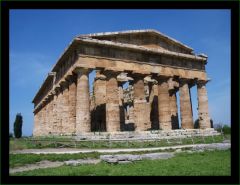
art historical period, culture, made from, year, name, story, location
|
art historical period archaic period, culture Greek, made from cement, year 550BCE, name Temple of hera I poseidonia, story named after posiden thickest doric order temple hera is a sister of zuse supports a pedament doric order only used for temples
|
|

art historical period, culture, made from, year, name, story, location
|
art historical period early classical period, culture Greek, made from marble, year 480 BCE, name kritios boy, story represents transition from archaic to classic period possibly represents a young god clearly shows skin stretched over mussle and bone shows naturalism & asemetracal. hair is styilized implied movement is interaction hands are still attached, location athens greece
|
|
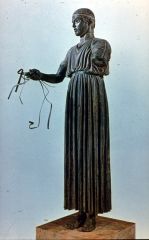
art historical period, culture, made from, year, name, story, location
|
art historical period early classical period, culture Greek, made from bronze, year 470BCE, name charioteer, story made from bronze hollow inside made in multiple peices used lost wax process to cast it he was originaly on a chariote pulled by 4 horses he represents a great charioteer still slightly asemetracal has individually cast eye lashes, location delphi Greece
|
|
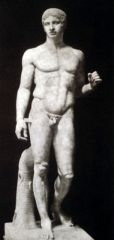
art historical period, culture, made from, year, name, story, location artist
|
art historical period high classical, culture Greek, made from marble, year 450, name doryphoros or spearbearer, story roman copy of bronze he was carring a spear orriginally heroic nude 7'tall mask of calmness, location rome??? artist polykleitos
|
|

art historical period, culture, made from, year, name, story, location, artist
|
art historical period late classical period, culture greek, made from marble, year 350, name aphrodite of knidos, story first nude female full round statue aphrodite god of love & beauty interaction between her & textiles ideal athletic female body has a feminine curve to her body placed in a temple of love, location rome, artist praxiteles
|
|
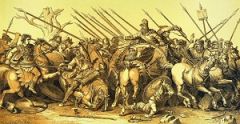
art historical period, culture, made from, year, name, story, location
|
art historical period hellenistic, culture greek, made from clay glass mosaic peices, year 310BCE, name battle of issus, story house of faun great example of forshortining & motion shows greeks understood shading & modeling space marks the end of the classical period, location greece
|
|
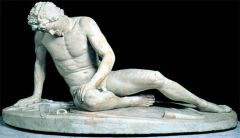
art historical period, culture, made from, year, name, story, location, artist
|
art historical period hellenistic, culture greek, made from marble, year 200BCE, name dying gallic trumpeter, story roman copy, location pergamon turky, artist epigonos
|
|
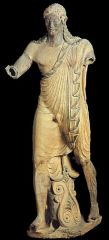
art historical period, culture, made from, year, name, story, location
|
art historical period etruscan , culture etruscan, made from terracotta hollo red clay sculpture, year 500BCE, name Apollo of Veii, story once placed in an etruscan temple part of a group that represents the battle of herculeas archaic style but has longer hair move ment and has clothes was painted, location veii italy
|
|
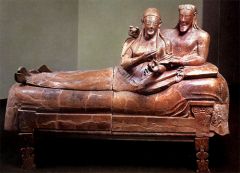
art historical period, culture, made from, year, name, story, location
|
art historical period etruscan, culture etruscan, made from clay taracotta, year 500BCE, name sarcophagus, story styilized 6ft long held ashes of decised placed in a tumuli shows happy couple lying on the dinning couch becconing you to come join them shows afterlife as a happy place, location cerveteri italy
|
|
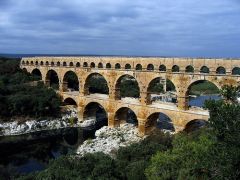
art historical period, culture, made from, year, name, story, location
|
art historical period republic, culture roman, made from cut stone, year 509-27, name pont du gard bridge & aquaduct, story over gard river based on arches its a public work built to accomidate troops & trade 900'long top level has a trough that moved water for 30miles from a spring to the center of the city the walls of the valley apply counter pressur, location nimes france
|
|
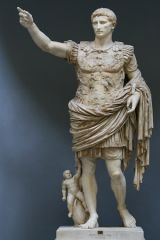
art historical period, culture, made from, year, name, story, location
|
art historical period empire, culture roman, made from marble, year 15CE, name statue of emperor augustus, story octavian changed his name to augustus after he became emperor statue is now in the vattican it was used as propaganda for augustus the theory is that it was made after his death because it shows him as a diety hes shown in his armor but focuses on him as an oritor, location rome
|
|

art historical period, culture, made from, year, name, story, location
|
art historical period empire, culture roman, made from concrete with brick arches, year 100CE, name pantheon, story hadrin sponsered this temple corithian columns dedicated to marcus agrippa called pantheon because it was dedicated to all the gods its a round temple with a domed roof coffered cealling gace the illusion of a taller cealing & lightened the weight of the roof, location rome Italy
|
|
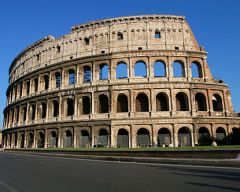
art historical period, culture, made from, year, name, story, location
|
art historical period empire, culture roman, made from concrete, year 100CE, name colosseum or flavian amphitheater, story titus completed it built to apease the people after the corrupt leader neo political propiganda to entertain the ppl & show that the new leadership was better its oval 50000ppl could fit in it has doric on the top ionic in the mid & corithian on the bottom has relief columns and a 25'deep foundation with rooms, location rome italy
|
|
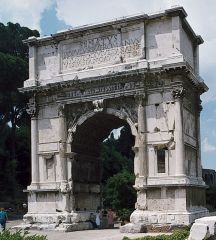
art historical period, culture, made from, year, name, story, location
|
art historical period empire, culture roman, made from cement with marble overlay, year 100CE, name triumphal arch of titus, story comissioned by titus brother after titus died its a free standing sculpture a permenant memorieal to military soldier stuff the enscription says the senet & emporos are dedicating this arch to devine titus... showing they concidered him to have been dieafied after he died this arch is covered in relief sculpture, location rome italy
|
|

art historical period, culture, made from, year, name, story, location
|
art historical period empire, culture roman, made from cement??, year 100CE, name trajans column, story 128' tall commissioned by hedrion after trajans death its built between 2 libraries trajans ashes are inside it has a winding ribbon of relief sculpture showing a defeat of the daciens out of the 25hundred people shown on this piller trajan is shown 150 times it acts a a momerial & political propeganda uses intuitive perspective, location germany
|
|
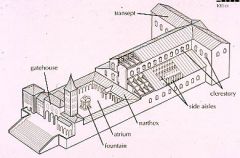
art historical period, culture, made from, year, name, story, location
|
art historical period early christian, culture early christian, made from brick & wood, year 325CE, name old saint peters, story roughly based on basillicas it was the 1st major christian church it was torn down to build new st peters church it was commissioned by the roman emperor constitine also functioned as a martyrium because its built over st peters burrial place it could hold 14000 ppl, location rome italy
|
|
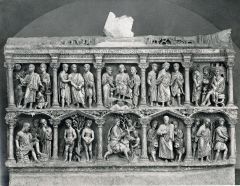
art historical period, culture, made from, year, name, story, location
|
art historical period early christian, culture early christian, made from marble, year 350CE, nameSarcophagus of Junius Bassus, story 4'long junius was a converted roman official the images on it are of the old & new testament old testiment is supporting newbecause its on the bottom, location rome italy
|
|
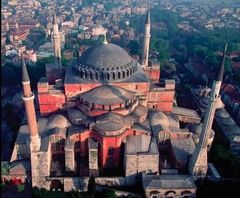
art historical period, culture, made from, year, name, story, location
|
art historical period Byzantine, culture Byzantine, made from brick & concrete, year 535, name Isidorus & Anthemius, Hagia Sophia , story holly wisdom (hagia sophia) private church for justinia & his court built as a monument to himselfe it was the first major christian church with a dome built by isidorus & anthemius dome has 40 windows took 5yrs to build it eventually became a mosk & is now a museme, location turky istanbul
|
|
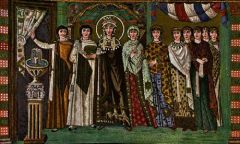
art historical period, culture, made from, year, name, story, location
|
art historical period Byzantine, culture Byzantine, made from glass or clay mosaic material, year 550, name Church of San Vitale Mosaics of Justinian and Theodora, story honoring san vitale centralized plan had lots of mosaics apse has retained its mosaics justinia is shown portrayed as Christ with maximianus & others justinia is portrayes as a royal diaty while still alive chiro symbol on the shield shows a religious focus. theodora is married to justinia the emporer is representational of mary this mosaic & justinians are connected through theodora & justinians locked gaze she is shown worshiping on the 2nd floor it shows that they are explicitily bound to heaven, location ravenna italy
|
|

art historical period, culture, made from, year, name, story, location
|
art historical period anglo saxon, culture early european, made from gold, year early 7th century, name hinged clasp, story ship was 87'long thought passangers were sailing to the other side textiles hides weapons riches were all sent on the ship with them the clasp is very refined gold work carved to make little spaces for moltant glass or thinly sliced jewls was used to fasten clok on the sholder & would have been sewn on, location sutton hoo england
|
|

art historical period, culture, made from, year, name, story, location
|
art historical period Hiberno-Saxon, culture early european, made from parchment & pigment, year 800, name Chi Rho Iota page from Book of Kells, story hiberono saxon was a mix of cultures celtic memorial cross metal work was choice Christ illuminated manuscript was made by monks in the Kells monistary in Ireland it came from a 680pg book resembles the metal brouches vices & virtues are pictured on this page in figuratives its a one of a kind symbolic beautiful object, location scotland/Ireland
|
|

art historical period, culture, made from, year, name, story, location
|
art historical period Carolingian, culture early european, made from ink & parchment, year 800, name Saint Gall Monastery Plan, story was never built benidictine rule self containes sustaining designed by a benidictine abot as a "perfect" monastery alter was in the east based on the crossing of Nave & ? one single measurement, location switzerland
|
|

art historical period, culture, made from, year, name, story, location
|
art historical period Ottonian, culture early european, made from bronze, year 1000, name Bishop Bernward's Doors of St. Michael's, story latin cross basillica plan stone church. bishop burnz commissioned these doors they are historicaly the most ambishious case of bronze casting they are 16' tall and each door was cast in 1 peice the left side has old testament stories the rt has new it was only used by monks they used lost wax casting teqnique to cast them, location Hildesheim, Germany
|
|
|
define Forum
|
forum (Latin, "marketplace"; pl. fora) was the public space in the middle of a Roman city
|
|
|
intuitive & atmospheric perspective
|
creates more believable space & color by fading the background out & darker
|
|
|
mosaic
|
art consisting of a design made of small pieces of colored stone or glass
|
|
|
architectural orders doric ionic corinthian
|
system for building temples doric was the thickest and least complex ionic is in the middle corinthian is the thinnest & most complex only used inside of temples
|
|
|
pediment
|
triangular shape above the metope
|
|
|
lost wax process
|
teqnique of casting sculptures
|
|
|
contrapposti
|
counter position
|
|
|
metope
|
little squares that represent old wood temples often have relief sculpture carved in them
|
|
|
foreshortening
|
space changes with distance
|
|
|
tumuli
|
domed toumb in a city of the dead cafrved from living rocks covered with moss & grass interiers mimic inside of etruscan house plaster relief sculpture primarily for elete. women shown lighter than men
|
|
|
atrium, narthex, nave, aisle, transept, apse, clerestory
|
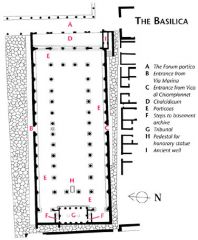
|

